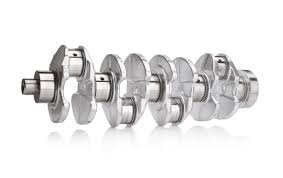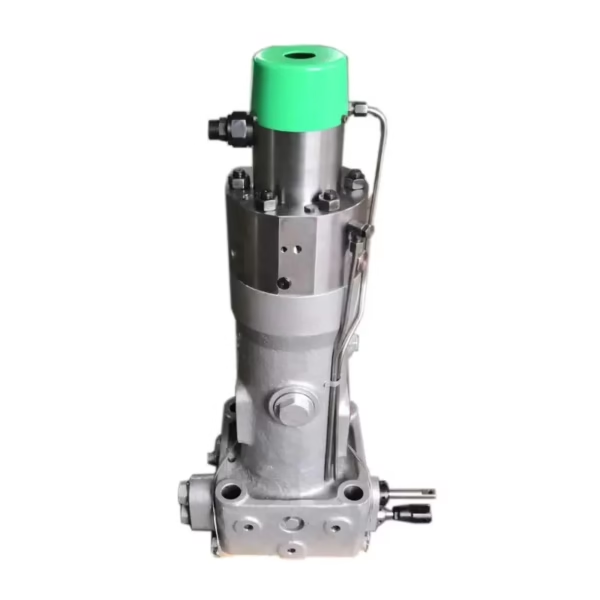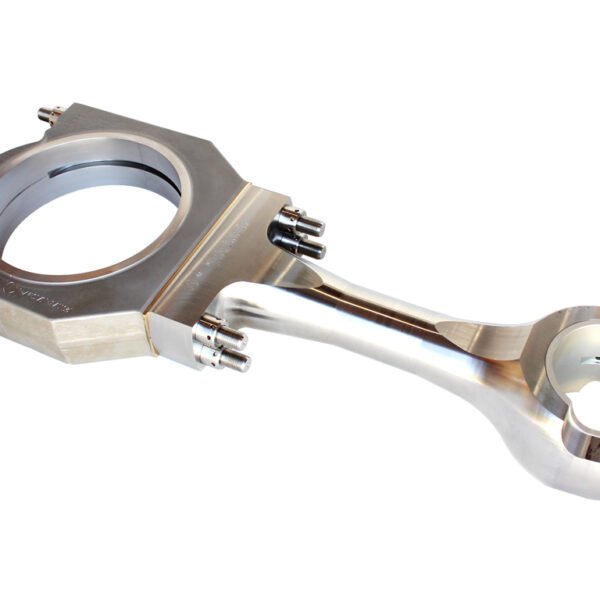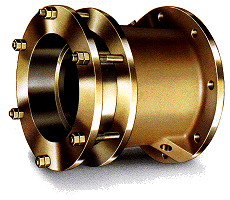A marine engine crankshaft is the pivotal component in an internal combustion engine that converts the reciprocating (up-and-down) motion of the pistons into rotational motion.1 It’s subjected to immense forces and is central to transmitting power from the engine to the propeller.2
Function and Design
The primary functions of a marine engine crankshaft are:
- Converting Linear to Rotary Motion: Through connecting rods, it transforms the linear force generated by the combustion in the cylinders into the rotational torque that drives the propeller.3
- Transmitting Power: It transmits the generated power from all cylinders to the flywheel and subsequently to the propulsion system.4
- Maintaining Timing: It’s intricately linked to the engine’s timing system, ensuring the precise opening and closing of valves and fuel injection.
Marine engine crankshafts are typically large, robust, and precisely machined components, often made from high-strength forged steel or cast steel. Their design features include:
- Journals: These are the polished cylindrical surfaces that ride within the main bearings (main journals) and connecting rod bearings (crankpin journals).5
- Crank Webs (Cheeks): These connect the journals and provide the offset that creates the “throw” for the pistons.6
- Counterweights: Strategically placed masses on the crank webs that balance the rotating and reciprocating forces, minimizing vibration and ensuring smooth operation.7
- Oil Passages: Internal drillings allow lubricating oil to be supplied under pressure from the main bearings to the crankpin bearings.8
Forces and Challenges
The crankshaft operates under severe conditions, enduring:
- Torsional Stress: Twisting forces due to power pulses from each cylinder.
- Bending Stress: Flexing forces caused by the weight of the components and dynamic loads.
- Shear Stress: Forces tending to cause parts of the shaft to slide past each other.
- Vibrational Stress: Fluctuations in torque and dynamic imbalances can induce resonant vibrations if not properly controlled.9
Given these stresses, common issues and critical considerations for crankshaft integrity include:
- Fatigue Cracks: The most serious concern, often originating from stress concentrations (e.g., fillet radii, oil holes) due to repeated cyclic loading. These can lead to catastrophic failure.
- Wear: On main and crankpin journals due to inadequate lubrication, contaminated oil, or bearing failures.10 Excessive wear leads to increased clearances, impacting bearing life and potentially causing vibration.
- Bending/Deflection: Can occur due to uneven loading, main bearing misalignment, or hull distortion, leading to increased stress and potential cracking.11 Regular crankshaft deflection readings are a crucial maintenance procedure to monitor alignment.12
- Corrosion: Pitting or surface damage from acidic oil or water contamination.13
- Damage from Foreign Objects: Ingested debris or bearing material fragments can score the journal surfaces.
Maintenance and Monitoring
Strict maintenance and monitoring protocols are essential for marine engine crankshafts:
- Regular Deflection Readings: Taken at specific intervals to check for misalignment between main bearings.14 Deviations indicate potential issues requiring investigation.
- Lubricating Oil Analysis: Monitoring oil quality, cleanliness, and the presence of wear metals is vital.
- Vibration Monitoring: Early detection of imbalances or excessive vibration can indicate underlying crankshaft issues.
- Non-Destructive Testing (NDT): Techniques like magnetic particle inspection (MPI) or ultrasonic testing (UT) are used during overhauls to detect surface or subsurface cracks.15
- Bearing Inspection/Renewal: Main and crankpin bearings are routinely inspected and replaced as part of planned maintenance to protect the crankshaft journals.
The crankshaft is a high-value, long-lead-time component, and its failure can result in extensive downtime and costly repairs.16 Proactive maintenance is thus paramount for ensuring the continuous and reliable operation of the vessel.
We offer an extensive range of marine engine brands and their associated spare parts, providing comprehensive solutions for both main propulsion and auxiliary power needs across diverse vessel types. Our supply capability covers various generations and models, ensuring support for a wide array of marine applications.
Featured Brands and Engine Series/Models:
SULZER:
- Two-Stroke Engines:
- RD/RND Series: RD68, RND76, RND76M, RND90, RND90M (Classic large-bore, low-speed engines, still in operation).
- RLA/RLB Series: RLA(B)56, RLA(B)66, RLA(B)76, RLB90 (Developed two-stroke designs).
- RTA/RT-Flex Series: RTA38, RTA48(T), RTA52, RTA58, RTA62, RTA72, RTA76, RTA84, RTA84M, RTA84C, RTA96 (Modern, fuel-efficient, electronically controlled two-stroke engines).
- Four-Stroke Engines:
- Z Series: ZL40/48, 16ZAV40S (Medium-speed engines).
- RF Series: RF44, RF56 (Often used for auxiliary power or generator sets).
- TAD Series: TAD36, TAD48 (For specific applications).
MAN (including pre and post-MAN B&W models):
- Two-Stroke Engines (KZ, KSZ, K, L, S, MC/MC-C, ME/ME-C): 40/54A, 52/90N, 57/80C, KZ57/80F, KSZ70/125, KSZ78/155, 90/160A, 52/55L, 58/64, 90/190C, L60/105E, 70/120E, 70/125C, L, KSZ78/155A, KSZ70/125B, L52/55A, 40/45 (A broad spectrum covering main propulsion and auxiliary engines).
B&W (Burmeister & Wain – prior to MAN B&W merger):
- MC/MCE Series: L35MC, L60MC, L80MC, L55GFCA, L80GFCA, L80GB, 74VT2BF, K62EF, K74EF, K84EF, K45GFC, K67GFK, K80GFK, K90GFS, 45HU, L70MC (Various generations of two-stroke diesel engines).
- MC-C/ME-C Series: L50MC, S60MC, S70MC, K80MC, S80MC, K90MC-C, L67GFCA, L90GB (Electronically controlled and conventional two-stroke engines).
- VT2BF/EF Series: 50VT2BF, 62VT2BF, K84EF (Older models still in service).
MITSUBISHI:
- UEC/UET Series: UEC37L/LA/LS, UEC45HA, UEC60L/LA/LS, UEC45L/LA/LS, UET45/75C, UEC52/125H, UEC52L/LA/LS, UET45/80D, UEC52/90D, UEC(T)52/105D, UEC45/115H, UEC37/88H, UEC37H (Mitsubishi’s proprietary two-stroke and some four-stroke engine series).
PIELSTICK:
- PA Series: PA6, PC3, PC2-2, IHI PC2-5, PC4, PC2-6, PC4-2L, PC4-570, PA5 (High-speed, compact four-stroke engines, commonly used for generator sets or auxiliary propulsion).
AKASAKA:
- UET/UEC/DM/AH Series: UET45/80D, UEC52/105D, DM51SS, UEC 60/150H, UEC 60H, A31, A34, A37, A41, AH27, AH28, AH30, AH36, AH38, AH40, DM30, DM36, DM38, DM46, DM47 (A prevalent engine brand, particularly in Japanese-built vessels).
DEUTZ:
- RBV/TBD/BVM Series: RBV8M358, RBV8M540, RBV16M640, TBD620L6, BVM350, BVM540, BF6M716 (Various four-stroke medium- and high-speed diesel engines for auxiliary and smaller main propulsion applications).
HANSHIN:
- EL/LH/LU/LUN/LUD/LUS Series: EL30, EL32, EL35, EL40, EL44, LH28RG, LH31G, LU28(A,R,G), LU32, LU35, LU38, LU46(A), LU50, LU54, LUN28, LUN30, LUD32, LUD35, LUS38 (Another significant engine brand commonly found in Japanese vessels).
NIIGATA:
- MG/M Series: MG40X(EX), M34X, 6M28BF, TM31X (Medium-speed diesel engines, typically used in small and medium-sized vessels).
MAK:
- M/MU/AK/AKM Series: M332, M453AK, MU551AK, MU552AK, M601, MU452AK, 451AK, 6M453AK, 9M453C, 6M601C, 8M601 (Medium-speed four-stroke engines, widely used in various marine applications).
WARTSILA:
- 20/22/26/32/38/46/GD/TKR Series: 22, 32, 31, 26, 20S, 28, 38, 46, 32GD, 46GD, 14, TKR22, HFR-V32, NOHAB (Wärtsilä’s broad portfolio of medium- and high-speed diesel engines for main propulsion, auxiliary, and generator sets).
DAIHATSU:
- PS/PKT/DS/DL/DK/PL Series: PS-18, PS-22, PS-20, PS-26, PS-30, PKT-14, PKT-16, PKTD-16, DS-18, DS-22, DS-26, DS-28, DS-32, DL-14, DL-16, DL-19, DL-20, DL-22, DL-24, DL-26, DK-20, PL-24 (Compact and reliable engines primarily used for auxiliary power and generator sets).
CUMMINS:
- BT/CT/NT/KTA/QSK/QSM Series: 4BT3.9, 6BT(A)5.9, 6CT8.3, NT(A)855, N14, KTA19, KTA38, KTA50, QSK19, QSM11 (Robust and durable engines for marine auxiliary power, generator sets, and some smaller main propulsion applications).
CATERPILLAR:
- 3000/3100/3300/3400/3500/3600 Series & C Series: 3054, 3056, 3066, 3106, 3126, 3306, 3406, 3408, 3412, 3508, 3512, 3516, 3606, 3608, 3612, 3616, 3618, C1.5, C2.2, C7, C9, C10, C12, C15, C16, C18, C30, C32 (Reliable and widely used engines across a vast range of main propulsion, auxiliary, and generator set applications).
SCANIA:
- DI Series: DI 09, DI 13, DI 16 (High-performance diesel engines designed for marine applications, typically used as auxiliary and smaller main propulsion engines).




